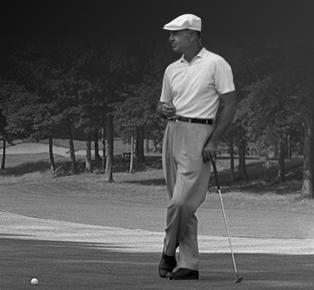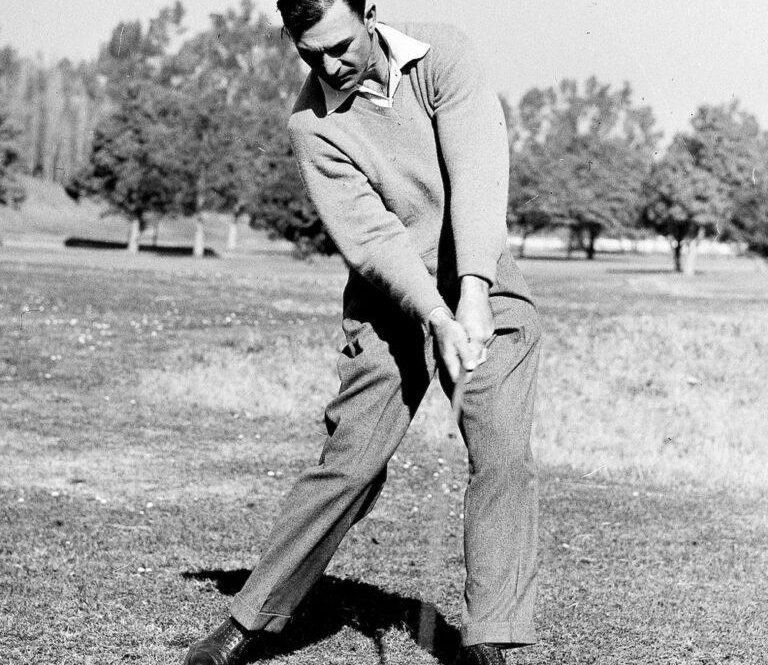Mastering Golf: An In-Depth Analysis of Ben Hogan’s Five Lessons
Ben Hogan, celebrated as one of the sport’s all-time greats, meticulously crafted his seminal work, “Five Lessons: The Modern Fundamentals of Golf,” to share his profound insights into the game. This analysis delves into the essential components of Hogan’s teachings, including swing mechanics, grip techniques, and posture alignment as detailed in this 128-page guide. By exploring these principles, golfers can unlock pathways to improved skills and performance on the course.
The Grip: Key Hand Placement and Pressure
A proper grip is fundamental in golf; it significantly influences club control and swing dynamics. Hogan stressed several critical aspects for achieving an effective grip:
- Hand Positioning: For right-handed players, the lead hand should rest comfortably atop the shaft with fingers interlocked and thumb slightly left of center. The trail hand should cradle the club with a palm-down position.
- Grip Pressure: Maintaining a firm yet relaxed grip is crucial for rhythm and accuracy. A tense hold can disrupt fluidity; thus, finding a balance is essential.
Grip Variations
| Grip Type | Hand Position | Best For |
|—————-|————————————————-|——————————|
| Interlocking | Fingers locked together | Stronger control |
| Overlapping | Lead hand fingers resting on trail hand | Comfortable feel |
| Ten-finger | All fingers gripping simultaneously | Weaker control |
Experimenting with different grips will help you discover what feels most natural for your swing style.
Swing Mechanics: Cultivating Tempo and Balance
The tempo of your swing—the rhythmic flow—plays a vital role in both accuracy and power. According to Hogan’s philosophy, maintaining a smooth tempo enhances momentum while ensuring consistency throughout your swings.
Balance is equally important; distributing weight evenly during your swing creates stability. Keep your head neutral with slightly bent knees while aligning feet shoulder-width apart to promote balance throughout each motion.
By mastering these elements—tempo and balance—you can achieve a more fluid swing that enhances precision while boosting power.
Posture Alignment: Building Blocks for Consistency
Proper posture serves as the foundation for an effective golf swing. Key elements include:
- Balanced Stance: Weight should be evenly distributed across both feet at hip-width apart while keeping eyes level along the target line.
- Spinal Angle: Maintain a slight forward tilt without excessive arching or pressing forward.
- Head Position: Tuck your chin slightly so that it aligns with your belt line; looking up or down can disrupt mechanics.
Adhering to these posture principles fosters stability during swings which allows optimal energy transfer leading to consistent strikes.
Benefits of Proper Posture
| Posture Principle | Advantages |
|—————————-|——————————————|
| Balanced Stance | Enhances overall stability |
| Spinal Angle | Regulates tempo and shot distance |
| Head Position | Prevents premature release |
Plane & Angle of Attack: Shaping Ball Trajectory
The plane on which you execute your golf swing directly affects ball trajectory. Visualize this plane as an imaginary surface guiding how you approach each shot—both vertically (like a wall) and horizontally (like ground).
The angle at which you strike impacts how effectively you hit the ball based on where it meets this plane during impact—a skillful player learns to navigate these angles adeptly for desired results regarding directionality and distance.
Finishing Position: Concluding Your Swing Effectively
Often overlooked but equally important as other phases are finishing positions within swings—they ensure complete turns alongside correct weight distribution necessary for generating power accurately:
- Fully rotate shoulders until they align correctly.
- Keep head down until after contact has been made.
- Extend arms fully ahead while maintaining slight wrist bend.
- Shift weight onto left foot upon completion.
Drill for Improving Finishing Positions
To enhance finishing positions effectively practice hitting balls into nets from close range focusing solely on completing turns whilst ensuring weight shifts appropriately towards left foot post-swing completion—this builds muscle memory crucially needed here!
Conclusion
Ben Hogan’s “Five Lessons” remains an invaluable resource across all skill levels within golfing communities today! Through understanding its core teachings outlined above golfers gain deeper insights into fundamental techniques applicable towards improving their overall performance out on courses everywhere! Mastery over golf transcends mere physical prowess—it embodies dedication toward precision coupled alongside relentless pursuit toward excellence!

Unlocking the Secrets of Ben Hogan’s Swing: A Deep Dive into His Five Lessons
Introduction to Hogan’s Philosophy
Ben Hogan’s Five Lessons: The Modern Fundamentals of Golf is not just a book; it’s a manual for every golfer aspiring to perfect their swing. Hogan, one of golf’s greatest players, distilled his vast experience and knowledge into five key lessons that cover all essential aspects of the golf swing. Understanding and applying these principles can unlock a golfer’s full potential.
The Five Lessons Explained
1. The Grip
The grip is arguably the most fundamental part of the golf swing. Hogan emphasized the importance of a proper grip to execute an effective swing.
- Types of Grips:
– Vardon Grip: The most popular grip style, where the pinky of the trailing hand overlaps the index finger of the lead hand.
– Interlocking Grip: Best suited for those with smaller hands, where the pinky and index fingers interlock.
- Key Takeaways:
– Ensure your grip is neutral to promote a straight shot.
– Hold the club with your fingers rather than the palms for better sensitivity.
2. The Stance
Hogan believed that a stable stance provides the foundation for a powerful swing.
- Balanced Stance:
– Feet shoulder-width apart for stability.
– Distribute weight evenly between both feet.
- Ball Position:
- For longer clubs, position the ball more forward in your stance.
– For shorter clubs, move it back slightly.
3. Posture and Alignment
Proper posture and alignment are critical for executing Hogan’s techniques effectively.
- Posture:
– Bend at the hips, not the waist, keeping your back straight.
– Slightly flex your knees to maintain balance.
- Alignment:
– Use an imaginary line to ensure your body is aligned with your target.
– Shoulders, hips, and feet should all point toward the same target line.
4. The Swing
Hogan broke down the swing into three distinct parts: the backswing, downswing, and follow-through.
- The Backswing:
– Initiate the swing with a one-piece takeaway.
– Rotate your shoulders to create tension in your arms.
- The Downswing:
– Start the downswing with your lower body, allowing your arms to follow.
– This sequence creates maximum power and control.
- The Follow-through:
– A complete follow-through is essential for maintaining balance.
- Finish high to ensure that you’ve followed through completely.
5. The Mental Game
Hogan believed that mental conditioning is as crucial as technical skills.
- Visualization: Picture your shot before you hit it.
- Focus: Maintain concentration and block out distractions to improve performance.
Benefits of Understanding Hogan’s Lessons
- Improved Performance: Mastering Hogan’s techniques can drastically improve swing accuracy and distance.
- Consistency: Consistent implementation of these fundamentals leads to better control on the course.
- Confidence Building: As golfers progress, their confidence grows, positively affecting their overall game.
Practical Tips for Implementation
1. Practice Grip Drills
- Drill: Use a weighted club to practice grips that provide better control and strength.
- Objective: Familiarize yourself with different grips while maintaining a relaxed hand.
2. Stance and Alignment Check
- Drill: Use alignment sticks during practice sessions to ensure correct setup.
- Objective: Build muscle memory for the correct stance and alignment.
3. Swing Mechanics
- Drill: Break down your swing into components—practice each part (backswing, downswing, follow-through) separately.
- Objective: Enhance the fluidity of your overall swing.
Case Studies from Golfers
Case Study 1: The Weekend Warrior
- Background: A once-a-week golfer struggled with slicing.
- Application: By focusing on grip and alignment, he reduced his slice and gained 15 yards on drives.
Case Study 2: The Competitive Player
- Background: A high school golfer aiming for a collegiate spot.
- Application: Incorporating Hogan’s mental game techniques, he was able to improve his focus, resulting in improved tournament performance.
First-Hand Experience: Transforming My Game
Having implemented Ben Hogan’s Five Lessons into my own practice routine, I can attest to their effectiveness. Initially, understanding grip and stance felt laborious, but dedicated practice transformed my performance. I noticed immediate improvements in my accuracy and confidence on the course within weeks. The clarity of ideas presented in Hogan’s work made complex techniques accessible, ensuring all golfers, regardless of skill level, can derive value from these lessons.
Unlock the full potential of your golf game by embracing the timeless teachings of Ben Hogan. Whether you’re aiming to lower your score or simply enjoy the game more, the principles laid out in Five Lessons are essential for any golfer serious about improvement. Explore these lessons deeply—your journey to golf mastery starts here, one swing at a time!
For more tips and insights, check out Golfer’s Paradise Blog for continuous learning and community support.




